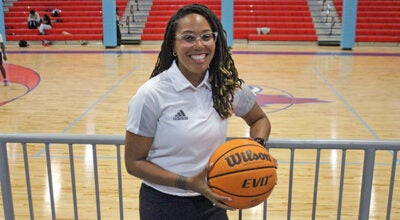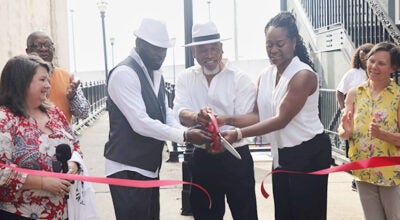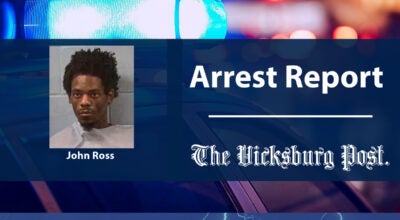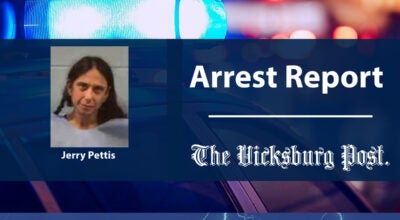VHS students to beam up conversation with space station
Published 12:00 am Wednesday, March 28, 2001
Amanda Norris practices asking questions of International Space Station crew members as fellow student Ebony Berry looks on. (The Vicksburg Post/MELANIE DUNCAN)
[03/28/01] Next week, eight Vicksburg High students will communicate with the three astronauts aboard the International Space Station. They will be the first students in Mississippi to talk with the Expedition Two crew.
“This is a history situation,” said Eddie Pettis, organizer of the event and president of the Vicksburg Amateur Radio Club. “The whole goal here was promoting ham radio and the education system.”
The ISS, started in 1995 with the Shuttle-Mir Program, is the largest and most complex international scientific project in history. Pioneered by the United States, it uses the technological and scientific resources of 16 nations, including Canada, Japan, Russia, 11 nations of the European Space Agency and Brazil. Upon its completion in 2006, the station will serve as a world-class, orbiting laboratory complex that will lead to advancements in medicine, materials and fundamental science and will facilitate future human space exploration.
Depending on when the ISS passes over the Vicksburg area, Pettis said, the students will talk with the crew April 4 at 4:37 a.m. or April 6 at 4:13 a.m. He and the students will not know the date of the contact until two or three days before it occurs, Pettis said.
The eight teens, chosen by VHS teacher Mike Brantley, came up with questions in their classes to ask the astronauts and were picked for the event based on those questions. They are sophomores Crystal Raner, Cameron Powers, Amanda Norris and William Hassell; junior Ebony Berry; and seniors Terrence Carter, Daniel Poole and Christopher Withrow.
Powers said she didn’t expect to get chosen for the ARISS contact and doesn’t mind getting up early to participate.
“I think it’s amazing,” she said. “It’s not every day you get to talk to an astronaut that’s actually in space.”
Berry and Hassell agreed.
“I’m going to have to go to bed real early,” Berry said. “But it doesn’t bother me because this is real special.”
“It’ll be tough, but it’ll be worth it,” Hassell said.
Powers said she plans to ask the astronauts about the differences between life in space and on Earth, and Berry wants to know what made the individuals aboard the ISS want to become astronauts.
Six years ago, Pettis submitted an application to Amateur Radio on the International Space Station, a program that allows students to talk with the ISS crew using amateur radio equipment. ARISS, sponsored by the American Radio Relay League, the Radio Amateur Satellite Corporation and NASA, notified Pettis in 1999 the VHS application was under review.
“I was delighted,” he said.
VHS principal Donald Taylor agreed. “We’re really excited about it and looking forward to it.”
Brantley, a physics and chemistry teacher, said he always has been interested in astronomy and space travel and hopes the ARISS contact will be a learning experience for the students.
“It really lets them get in touch with the space program,” he said. “It makes it really personal.”
“They are the future of space technology,” Pettis said. “We hope they can make some connection between high school and where they want to go.”
The students will make contact with the ISS as it passes about 200 miles above Earth, Pettis said, using equipment including a computer for tracking, a 50-foot tower, movable and stationary antennae, rotors, an amplifier and 150 feet of cable. Each teen has two questions prepared for the 10-minute session, which will occur in the VHS library. However, whether or not a student gets to participate depends on the length of the astronauts’ answers.
“Hopefully, everybody gets to ask at least one question,” Pettis said.
Pettis has an operating station in his home and donated much of the equipment needed for the ARISS contact. Using his station, Pettis has talked with the astronauts aboard the Shuttle-Mir, the spacecraft used to complete the first phase of the ISS.
“We can run five watts and talk with the world,” he said. “With a ham radio, you can communicate anywhere on the face of the Earth.”
Besides Pettis, other local radio club members, including Russ Tillman and Bill Ford, have provided equipment and labor for the project. Plaques are being given to the eight students by Vicksburg Chemical Company, and the City of Vicksburg is donating T-shirts for them to wear during the ARISS contact.
“We just wanted to give the kids something to remember,” Pettis said.
VHS will be the first high school in Mississippi to make contact with the ISS. In 1997, students at Harper McCaughan Elementary School in Long Beach communicated with John Blaha, an astronaut aboard the Russian Mir Space Station, which is not part of the ISS. After a 15-year orbit, the station returned to Earth last week.
Expedition Two crew members are commander Yury Usachev and flight engineers Jim Voss and Susan Helms. During its four-month stay, the crew will perform 18 experiments and is expected to conduct the first station-based space walk. The Expedition One crew returned to Earth last Wednesday after 141 days in space.





